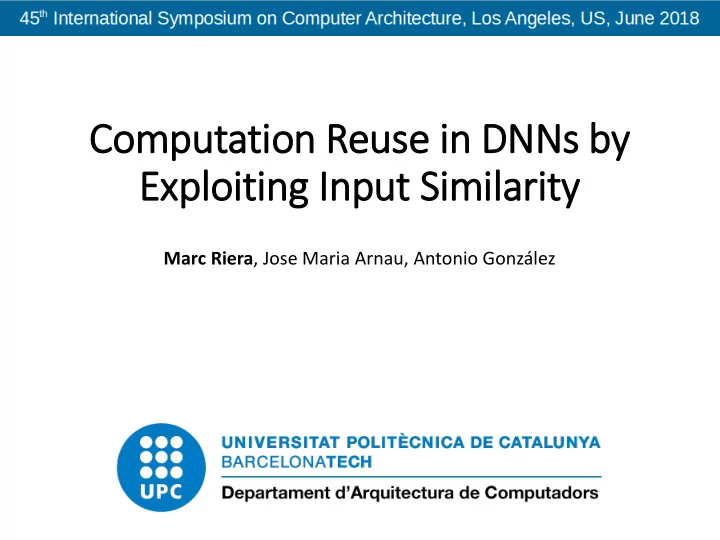

Computatio ion Reuse in in DNNs by Exploiting Input Sim imilarity Marc Riera , Jose Maria Arnau, Antonio González
Sequence Processing Applications Speech Audio Signal 4/06/2018 ISCA 2018 2
Sequence Processing Applications 4/06/2018 ISCA 2018 3
Sequence Processing Applications 4/06/2018 ISCA 2018 4
Sequence Processing Applications 4/06/2018 ISCA 2018 5
Sequence Processing Applications Speech Recognition DNN executions to classify a sequence of audio frames in phonemes 4/06/2018 ISCA 2018 6
Benchmarks DNN Name DNN Type DNN Application #Parameters Accuracy Kaldi MLP Acoustic Scoring 4,7M 89,04% EESEN RNN Speech Recognition 11M 68,85% C3D CNN Video Classification 78M 93,48% AutoPilot CNN Self-Driving Cars 1,6M 99,63% 4/06/2018 ISCA 2018 7
In Input Sim imilarity 90% 77% 80% 69% 70% 61% 60% Input Similarity (%) 52% 50% 45% 40% 30% 20% 10% 0% Kaldi C3D Autopilot EESEN Average 4/06/2018 ISCA 2018 8
Exploiting Temporal Sim imilarity Example Baseline 𝑥 0 𝑗 𝐽 0 𝑃 𝑗 = 𝐽 0 𝑗 𝑥 0 + 𝐽 1 𝑗 𝑥 1 + 𝐽 2 𝑗 𝑥 2 + 𝑐 𝑥 1 𝑗 𝐽 1 Frame i N 𝑥 2 𝑗 𝐽 2 𝑗+1 𝑥 0 𝐽 0 𝑃 𝑗+1 = 𝐽 0 𝑗+1 𝑥 0 + 𝐽 1 𝑗+1 𝑥 1 + 𝐽 2 𝑗+1 𝑥 2 + 𝑐 𝑥 1 𝑗+1 𝐽 1 Frame i+1 N 𝑥 2 𝑗+1 𝐽 2 4/06/2018 ISCA 2018 9
Exploiting Temporal Sim imilarity Example Proposal 𝑥 0 𝑗 𝐽 0 𝑃 𝑗 = 𝐽 0 𝑗 𝑥 0 + 𝐽 1 𝑗 𝑥 1 + 𝐽 2 𝑗 𝑥 2 + 𝑐 𝑥 1 𝑗 𝐽 1 Frame i N 𝑥 2 𝑗 𝐽 2 𝑗+1 𝑥 0 𝐽 0 𝒋 )𝒙 𝟑 𝑷 𝒋+𝟐 = 𝑷 𝒋 + (𝑱 𝟑 𝒋+𝟐 −𝑱 𝟑 𝑥 1 𝑗+1 𝐽 1 Frame i+1 N Number of computations before = 6 𝑥 2 𝑗+1 Number of computations after = 2 𝐽 2 Note : Substraction of the inputs is almost negligible since its performed once per input 4/06/2018 ISCA 2018 10
Computatio ion Reuse 90% 79% 80% 74% 70% 66% Computation Reuse (%) 60% 55% 53% 50% 40% 30% 20% 10% 0% Kaldi C3D Autopilot EESEN Average 4/06/2018 ISCA 2018 11
DNN Processing Unit Tile 4/06/2018 ISCA 2018 12
FC Execution in the Reuse Accelerator (1) 4/06/2018 ISCA 2018 13
FC Execution in the Reuse Accelerator (2) 4/06/2018 ISCA 2018 14
FC Execution in the Reuse Accelerator (3) 4/06/2018 ISCA 2018 15
Other Supported Layers Convolutional Neural Network (CNN) Recurrent Neural Network (RNN) 4/06/2018 ISCA 2018 16
Evalu luation Methodology • Simulator to evaluate the performance and energy of the accelerator • Design Compiler to obtain power and delay of logic modules • 28/32nm library from Synopsys and the DesignWare logic modules • CACTI used for SRAM and eDRAM memories • MICRON LPDDR4 for main Memory • Accelerator Configuration: 4/06/2018 ISCA 2018 17
Memory ry Footprint Overheads 20 18 16 14 Memory Increase (%) 12 10 8 6 4 2 0 On-Chip IO Buffer Off-Chip Main Memory 4/06/2018 ISCA 2018 18
Results: SpeedUp 4/06/2018 ISCA 2018 19
Results: Energy Savin ings 4/06/2018 ISCA 2018 20
Conclusions • More than 60% of the inputs remain unmodified respect the previous execution • Our proposed scheme checks which inputs have changed: • Unmodified inputs are ignored, avoiding computations and memory accesses • Modified inputs are used to correct the previous output of each neuron • On average, 63% energy savings and 3.5x speedup • Small area overhead of less than 1% mainly for additional storage 4/06/2018 ISCA 2018 21
Computatio ion Reuse in in DNNs by Exploiting Input Sim imilarity Marc Riera , Jose Maria Arnau, Antonio González
Recommend
More recommend